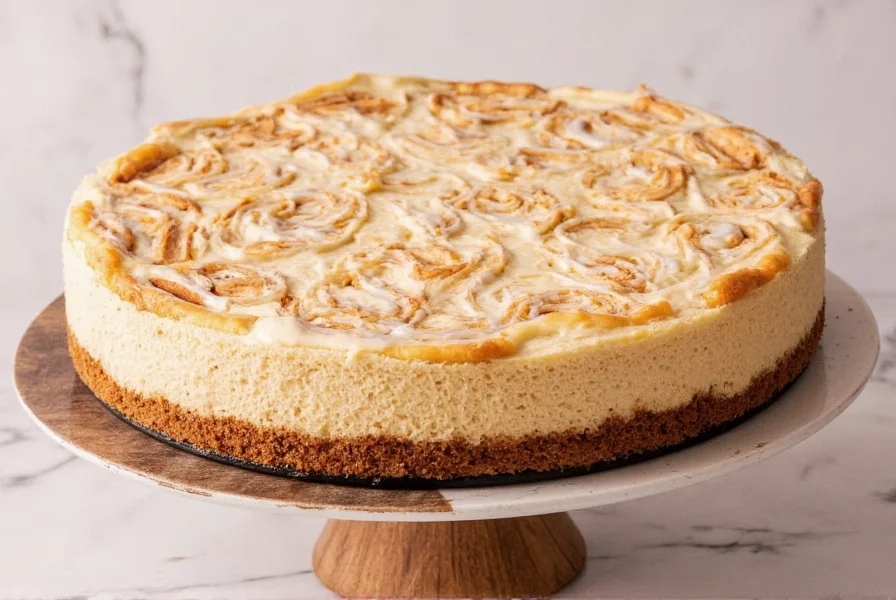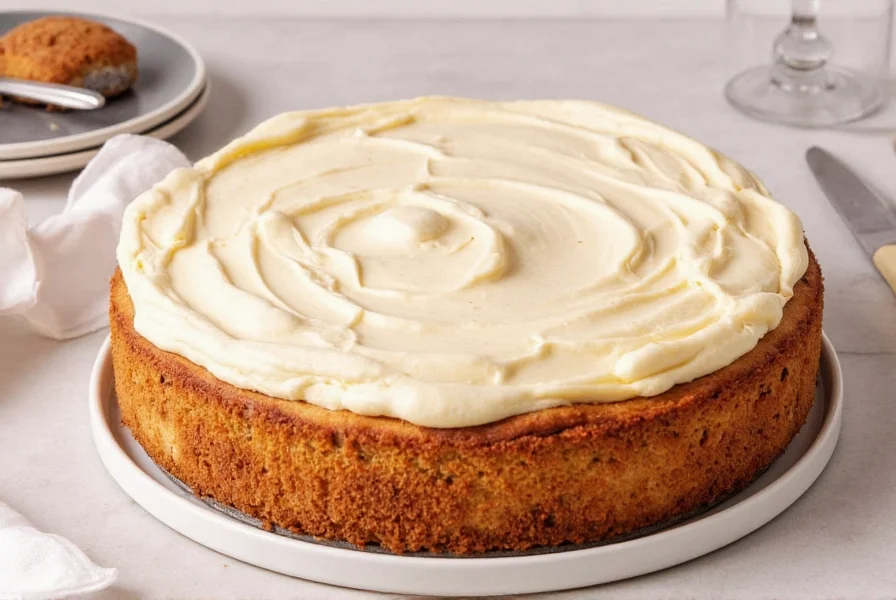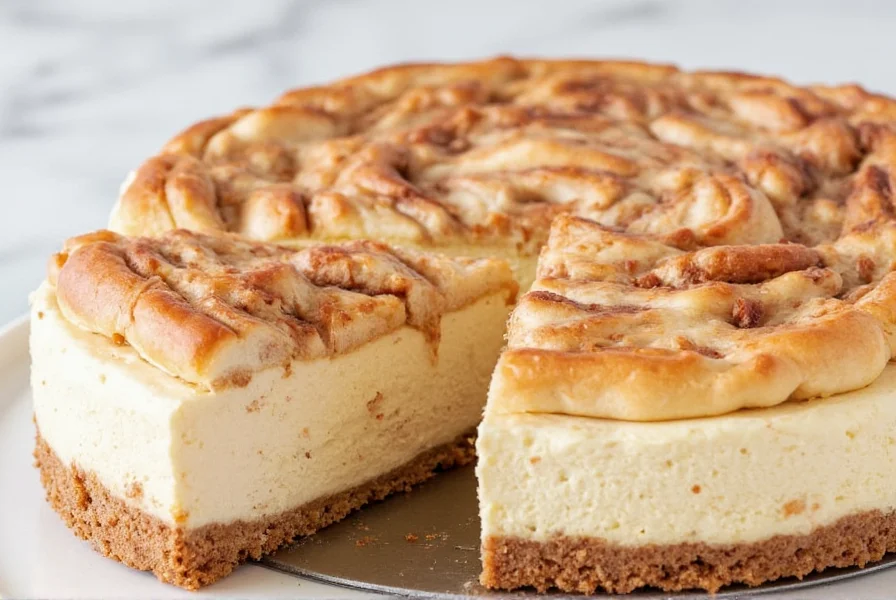If you've ever wondered how to merge two beloved desserts into one spectacular treat, cinnamon bun cheesecake delivers exactly that. This creative fusion has gained popularity for good reason—it offers the comforting spices of cinnamon buns with the elegant simplicity of a cheesecake. Unlike traditional cheesecakes that rely solely on fruit or chocolate toppings, this version incorporates the full flavor profile of Swedish kanelbullar directly into the dessert's structure.
The Secret Behind Perfect Cinnamon Bun Cheesecake
What sets exceptional cinnamon bun cheesecake apart from ordinary cheesecake? The magic happens in three distinct layers that work together harmoniously. First, a buttery graham cracker crust gets mixed with brown sugar and cinnamon for that unmistakable bun foundation. Then comes the smooth cheesecake layer made with full-fat cream cheese, which provides the ideal canvas for cinnamon infusion. Finally, the signature sticky topping—typically a buttery caramel sauce with extra cinnamon—gets poured over the cooled cheesecake, creating that authentic cinnamon roll experience.

Essential Ingredients for Authentic Flavor
Using quality ingredients makes all the difference in achieving that perfect cinnamon bun cheesecake taste. For the most authentic results, seek out Swedish cinnamon (which has a sweeter, more delicate flavor than regular cinnamon) and high-fat cream cheese. Many bakers swear by Philadelphia cream cheese for its consistent texture and rich flavor that doesn't curdle easily during baking.
| Component | Key Ingredients | Why They Matter |
|---|---|---|
| Crust | Graham crackers, melted butter, brown sugar, cinnamon | Creates the foundational cinnamon bun texture and flavor |
| Filling | Cream cheese, sugar, eggs, sour cream, vanilla, cinnamon | Provides smooth texture with balanced tang and spice |
| Topping | Butter, brown sugar, heavy cream, cinnamon, pecans (optional) | Delivers the signature sticky, caramelized finish |
Step-by-Step Baking Process
Creating the perfect cinnamon bun cheesecake requires attention to detail at each stage. Start by preparing your springform pan with parchment paper to prevent sticking—this is crucial for clean slices later. For the crust, combine 1½ cups graham cracker crumbs with ¼ cup brown sugar, 2 teaspoons cinnamon, and 6 tablespoons melted butter. Press firmly into the bottom of your pan and bake for 10 minutes at 325°F (163°C) to set.
While the crust cools, prepare your filling. Beat 24 ounces of room-temperature cream cheese with 1 cup sugar until smooth, then add 3 large eggs one at a time. Mix in 1 cup sour cream, 2 teaspoons vanilla, and 1½ teaspoons cinnamon. Pour this mixture over your cooled crust.
The baking process requires careful temperature control. Bake at 325°F (163°C) for 50-55 minutes until the edges are set but the center still has a slight jiggle. This prevents cracking while ensuring proper texture. After baking, turn off your oven, crack the door, and let the cheesecake cool gradually inside for one hour—this slow cooling prevents dramatic temperature changes that cause cracks.

Perfecting the Sticky Topping
The topping transforms ordinary cheesecake into authentic cinnamon bun cheesecake. While your cheesecake chills overnight (essential for proper setting), prepare the topping by melting ½ cup butter with 1 cup brown sugar, ¼ cup heavy cream, and 1 teaspoon cinnamon over medium heat. Bring to a gentle boil for 3 minutes, then remove from heat and stir in ½ cup chopped pecans if desired.
Pour this warm topping over your completely chilled cheesecake just before serving. The contrast between the cool cheesecake and warm topping creates that irresistible cinnamon roll experience. For best results, let the topping sit for 15 minutes to slightly set before slicing.
Common Mistakes to Avoid
Even experienced bakers encounter pitfalls with cinnamon bun cheesecake. Overmixing the batter incorporates too much air, causing cracks during baking. Using cold ingredients leads to lumpy filling—always bring cream cheese, eggs, and sour cream to room temperature first. Another common error is cutting the cheesecake too soon; it needs at least 8 hours (preferably overnight) to set properly.
For those wondering how long to bake cinnamon bun cheesecake, remember that oven temperatures vary. The 50-55 minute guideline is just a starting point—your cheesecake is done when the outer inch is set but the center still jiggles slightly when gently shaken.
Variations for Every Occasion
Once you've mastered the basic cinnamon bun cheesecake recipe, try these popular variations:
- Swedish-style: Add cardamom to both the crust and filling for authentic Scandinavian flavor
- Mini cheesecakes: Prepare in muffin tins for individual servings that bake in 25-30 minutes
- Vegan version: Use coconut cream cheese alternative and maple syrup instead of honey in the topping
- Coffee-infused: Add 1 tablespoon instant espresso powder to the filling for a mocha-cinnamon twist
Storage and Serving Recommendations
Proper storage maintains your cinnamon bun cheesecake's texture and flavor. Keep it covered in the refrigerator for up to 5 days. For longer storage, freeze slices individually wrapped in plastic wrap and placed in an airtight container for up to 2 months. Thaw in the refrigerator overnight before serving.
When serving, use a hot knife for clean slices—dip your knife in hot water and wipe dry between cuts. Pair with strong coffee or vanilla ice cream to complement the rich, spiced flavors. This dessert shines at brunches, holiday gatherings, or as an impressive finale to dinner parties.
What's the difference between cinnamon bun cheesecake and regular cheesecake?
Cinnamon bun cheesecake incorporates cinnamon and brown sugar directly into both the crust and filling, plus features a signature sticky caramel topping that mimics traditional cinnamon rolls. Regular cheesecake typically has a plain graham cracker crust and relies on fruit compotes or chocolate sauces for flavor variation.
Can I make cinnamon bun cheesecake without a springform pan?
Yes, you can use a regular cake pan lined with parchment paper that extends above the rim. This creates 'handles' to lift the cheesecake out after chilling. Aluminum foil pans also work well as they can be carefully peeled away from the set cheesecake.
Why does my cinnamon bun cheesecake crack on top?
Cracking usually occurs from overbaking, rapid temperature changes, or overmixing the batter. To prevent cracks, bake until the edges are set but the center still jiggles slightly, cool gradually in the turned-off oven with the door cracked, and avoid incorporating too much air when mixing ingredients.
How far in advance can I make cinnamon bun cheesecake?
Cinnamon bun cheesecake actually improves with time as flavors meld. You can prepare it 2-3 days in advance. Make the cheesecake base, chill completely, then add the sticky topping just before serving to maintain the perfect texture contrast between the cool cheesecake and warm topping.
Can I use pre-made cinnamon roll dough for this recipe?
While possible, pre-made cinnamon roll dough creates a different texture than the traditional graham cracker crust. For authentic cinnamon bun cheesecake, the crust should be crumb-based rather than yeast-based to maintain the proper cheesecake consistency throughout.
Frequently Asked Questions
- What's the difference between cinnamon bun cheesecake and regular cheesecake?
- Cinnamon bun cheesecake incorporates cinnamon and brown sugar directly into both the crust and filling, plus features a signature sticky caramel topping that mimics traditional cinnamon rolls. Regular cheesecake typically has a plain graham cracker crust and relies on fruit compotes or chocolate sauces for flavor variation.
- Can I make cinnamon bun cheesecake without a springform pan?
- Yes, you can use a regular cake pan lined with parchment paper that extends above the rim. This creates 'handles' to lift the cheesecake out after chilling. Aluminum foil pans also work well as they can be carefully peeled away from the set cheesecake.
- Why does my cinnamon bun cheesecake crack on top?
- Cracking usually occurs from overbaking, rapid temperature changes, or overmixing the batter. To prevent cracks, bake until the edges are set but the center still jiggles slightly, cool gradually in the turned-off oven with the door cracked, and avoid incorporating too much air when mixing ingredients.
- How far in advance can I make cinnamon bun cheesecake?
- Cinnamon bun cheesecake actually improves with time as flavors meld. You can prepare it 2-3 days in advance. Make the cheesecake base, chill completely, then add the sticky topping just before serving to maintain the perfect texture contrast between the cool cheesecake and warm topping.
- Can I use pre-made cinnamon roll dough for this recipe?
- While possible, pre-made cinnamon roll dough creates a different texture than the traditional graham cracker crust. For authentic cinnamon bun cheesecake, the crust should be crumb-based rather than yeast-based to maintain the proper cheesecake consistency throughout.











 浙公网安备
33010002000092号
浙公网安备
33010002000092号 浙B2-20120091-4
浙B2-20120091-4